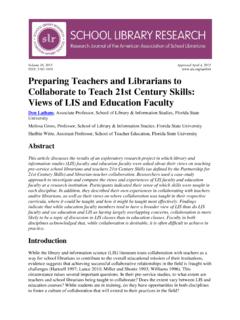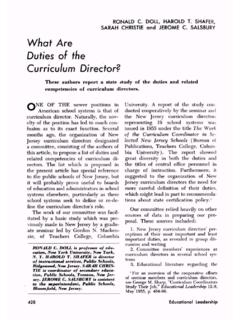Transcription of CWR Applicant Handbook Revisions 8,12,13
1 Certified wildlife Rehabilitator . CWR Applicant 's Handbook CWR. international wildlife rehabilitation council Post Office Box 3197. Eugene, OR 97403 USA. Phone: 866-871-1869. Fax: 408-876-6153. Email: TABLE OF CONTENTS. Introduction to the Certified wildlife Rehabilitator .. 3. Explanation of Procedures and 4. Exam Topics and Exam Preparation and Study 7. Cover photo credits, from top to bottom: Sue Hammer, USFWS, USFWS, USFWS, Jim Isaacs, Jean Chamberlain, Toronto wildlife Center CWR Applicant 's Handbook 2. INTRODUCTION TO THE CERTIFIED. wildlife REHABILITATOR . What is Professional Certification? Professional certification is a designation given to an individual who has demonstrated the knowledge and/or skills needed to perform a specific job. Certification is generally a voluntary process created by representatives of a specific vocation to establish and promote high standards among its practitioners. An individual does not have to be employed within the profession to be eligible for professional certification.
2 Individuals become certified through training and/or passing an exam. Once an individual achieves professional certification, they are allowed to promote their status by appending the certification abbreviation to their name. For example, Ani Myotis, CMA indicates Ms. Myotis is a Certified Medical Assistant. Certifications may be valid for the life of the individual or may require periodic renewal; the latter is common in technically-oriented professions where standards and practices are constantly being updated. Often the renewal process requires evidence of continual learning, generally in the form of continuing education units (CEUs). Certifications are offered and administered by a certification body. Certification bodies are usually national or international professional organizations. The certification body determines the policies of the certification program, administers any required exams, and maintains certification records.
3 Why does wildlife rehabilitation need professional certification? In much of the world, many vocations require a specific degree from an accredited educational institution that includes an established curriculum. These educational prerequisites are established in an attempt to insure that everyone involved has demonstrated a level of competency in related areas of study. In the care-giving vocations, these requirements are an attempt to ensure a minimum standard of care. Because the field of wildlife rehabilitation is a fairly new vocation, the requirements for becoming a legal practitioner are in constant flux and they vary widely around the world. Depending on geographic area, a rehabilitator may be required to undergo a lengthy apprenticeship followed by a challenging qualifier exam prior to being allowed to practice, while in other areas the individual may not need to demonstrate any knowledge or skill at all. This challenges the credibility of our field and the work that we do.
4 The Certified wildlife Rehabilitator provides a reliable validation of training and experience that will accelerate professional development and enhance credibility. Certification shows permitting agency personnel, veterinarians, grant organizations, members of the public, and your fellow rehabilitators that you are committed to professionalism and providing the highest quality care. Certification is a mark of excellence you carry wherever you go. CWR Applicant 's Handbook 3. PROCEDURES AND FEES. Certification Body The international wildlife rehabilitation council (IWRC) acts as the administration body and the Certification Review Board as the certification body for the CWR program. It is important to note that you are NOT required to be a member of IWRC or any other organization in order to be eligible for certification, nor are you required to take any classes or purchase publications from any organization, permitting agency, community college, or university.
5 Certification Requirements The only requirement to achieve certification status is to take and pass the CWR examination. Certification Exam The CWR examination consists of fifty randomly generated questions including true/false, multiple choice, and matching. As the questions for each exam are drawn from a database of over 12,000, each individual exam is unique. The exam is open book and candidates may access hard-copy study materials while taking the exam. The exam is timed and must be completed within 60. minutes. The CWR examination is available in two formats: online and hard-copy. Online exams: The online exam is administered via the CWR website using a temporary password. While the exam is open, the testing software does not allow access to any other files or programs, including the Internet. Online exams are graded automatically upon submission and candidates receive immediate notification of their results. Hard-copy documentation is mailed to candidates who pass.
6 Candidates who do not pass will receive information on re-testing opportunities via email. Hard-copy exams: A hard-copy testing packet is sent directly to a candidate-identified and staff- approved proctor (see Proctors section below). The packet includes a paper copy of the exam, instructions for administering the exam and a self-addressed, stamped enveloped with which to return the exam for grading. Proctors are not provided with an answer key. Once the exam has been graded, candidates will be notified of the results via email (or mail if an email address has not been provided). Hard-copy documentation is mailed to candidates who pass. Candidates who do not pass will receive information on re-testing opportunities via email (or mail if an email address has not been provided). Re-testing Regardless of the exam format chosen, candidates who do not pass the exam are allowed as many re- take opportunities as needed. A re-testing fee is required for each attempt (see Fees section below).
7 And a minimum of two weeks between each attempt is mandatory. A new, randomly-generated exam is provided for each attempt. Proctors A proctor is a person who supervises the taking of an examination to assure that all rules are followed. CWR candidates who choose the proctored hard-copy format must submit the name and contact information of the individual they would like to serve as proctor for approval. Potential CWR Applicant 's Handbook 4. proctors must not be related to the candidate, or have a vested interest in the candidate's results ( , a center rehabilitation manager). Acceptable proctors include, but are not limited to: Secondary level or higher public or private school teachers and/or administrators Librarians Private testing center personnel Notaries public Members of the clergy Grading The CWR exam is graded on a Pass / Fail basis. In order to pass, candidates must correctly answer a minimum of 38 out of 50 questions.
8 It is important to note that candidates do not receive a numerical score, or information on which questions they answered incorrectly only a Pass or Fail is given. Certification Renewal wildlife rehabilitation is a rapidly changing field, and rehabilitators need to continually update their knowledge and skills in order to provide the best possible care to the animals they receive. To encourage the highest level of knowledge, skill and competence, CWR certification must be renewed every two years. Renewal candidates must accrue and show proof of two continuing education units (CEUs) during the two-year period to qualify for renewal. Continuing Education Units Continuing Education Units (CEUs) may be obtained by any of the following: 8 hours of attendance at an approved wildlife -related conference = 1 unit 8 hours of attendance at an approved wildlife -related training class or workshop = 1 unit Presentation of a paper at an approved regional or national wildlife -related conference = 1 unit Publication of a paper in an approved peer-reviewed wildlife -related journal = 2 units Classes, workshops, conferences and journals used for CEUs must be pre-approved.
9 A list of approved CEUs and the guidelines and procedures for receiving approval are available upon request. It is possible to earn CEUs in increments. For example, you might see a four-hour training class on the approved list; this specific class would be approved for four hours of continuing education, or CEUs. Acceptable proof of attendance includes a certificate of completion or a receipt signed and dated by a representative of the event coordinator. Fees The following are the fees associated with the CWR: Application fee: $115 per application Re-testing fee: $40 per attempt Renewal fee: $40 per cycle CWR Applicant 's Handbook 5. Exam Topics and Concepts The list below provides an overview of the twelve topics, and examples of specific concepts related to each topic. Each exam includes questions on each of the twelve topics listed, however as each exam is unique, there will be variation in the concepts covered. 1) ID, Natural History & Behavior 6) Hydration & Fluid Therapy i) Using field guides i) Dehydration assessment - ranges, habitats, classification, ii) Rehydration calculations abundance iii) Routes of fluid administration ii) Identification iv) Types of solutions - trophic category based on beak, trophic category based on 7) Thermoregulation dentition i) Traits of hyperthermia iii) Types of interrelations ii) Traits of hypothermia - commensalisms, parasitism, iii) Thermoregulatory therapies mutualism iv) Reproduction & development 8) Wound Management i) Initial treatment 2) Handling, Restraint & Human Safety ii) Debridement methods i) Handler safety issues iii) Assessing need for sutures ii) Basic restraint iv) Stages of wound granulation iii) Major zoonotic diseases iv) Public health and safety 9) Medications i) Drug dosages and calculations 3) Basic Physiology ii) Reading and using a syringe i) Basic cell structure iii)
10 How antibiotics work ii) Nervous system iv) How steroids work iii) Metabolism - glycolysis, cellular respiration 10) Nutrition iii) Heart and respiration i) Trophic categories - cardiac function, mammalian ii) Micronutrients respiration, avian respiration iii) Macronutrients iv) Osmosis and circulation iv) Calculating daily energy needs - osmolality, blood components v) Calculating stomach capacity v) Skeletal & muscle systems vi) Metabolic bone disease - fracture response, muscle groups - symptoms and therapy vi) Digestive & excretory systems vii) Emaciation - metabolic waste, filtration, digestive process 11) Captive Housing i) Isolation/quarantine 4) Intake, Triage & Stabilization ii) Substrates i) Steps of intake exam iii) Caging based on medical status ii) Triage concepts iv) Basic housing design iii) Phone triage iv) Basic stabilization 12) Release Criteria v) When to call in a veterinarian i) Medical release criteria ii) Behavioral release criteria 5) Euthanasia iii) Habitat assessment i) What is euthanasia iv) carrying capacity ii) Euthanasia assessment v) Preventing human- wildlife conflicts iii) Euthanasia methods vi) Coordinating with wildlife agencies iv) Legal necessity CWR Applicant 's Handbook 6.

